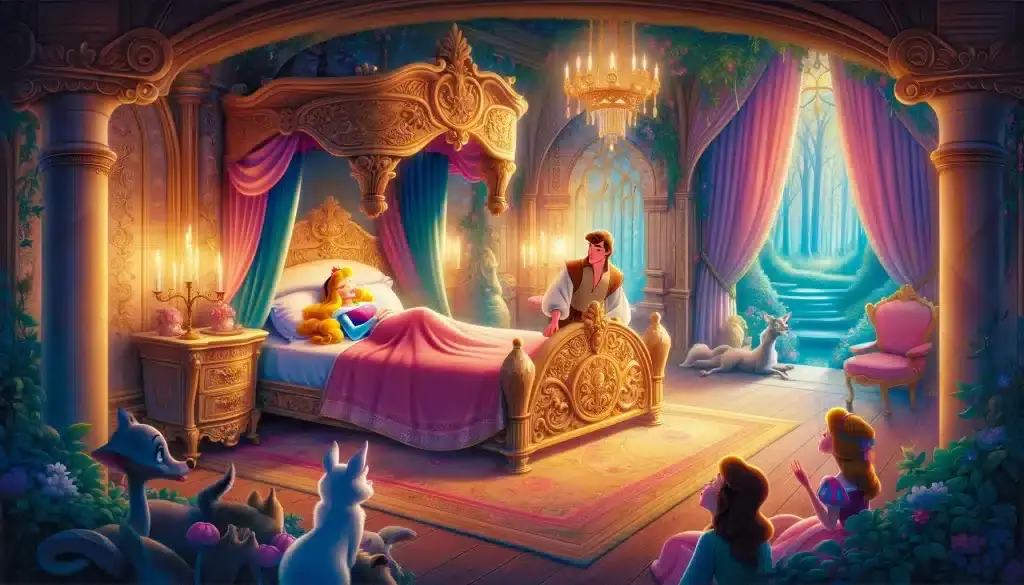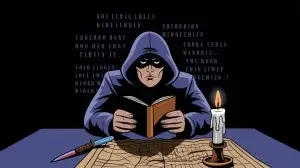The History of Sleeping Beauty has been captivating audiences for centuries. From the original Italian version published in the Pentamerone in 1634 to the beloved ballet adaptation by Tchaikovsky, the story has undergone many iterations over the years. But what is the true history of Sleeping Beauty?

The origins of the Sleeping Beauty tale are difficult to trace, as it has been told and retold in various forms throughout history. Some early contributions to the story include the medieval courtly romance Perceforest, published in 1528, and the Italian version published in the Pentamerone. Charles Perrault’s version, published in the late 17th century, popularized the tale in France and introduced the character of the fairy godmother. The Brothers Grimm also included their own version of the story in their collection of fairy tales, calling the heroine Dornröschen or “Little Briar Rose.
Despite the many different versions of the story, the basic plot remains the same: a princess falls into an enchanted sleep and can only be awakened by true love’s kiss. The story has been adapted into countless forms of media, including books, films, and even video games. Its enduring popularity is a testament to the power of fairy tales to capture the imagination and inspire wonder in audiences of all ages.
Origins of Sleeping Beauty
The story of Sleeping Beauty, also known as La Belle au Bois Dormant, is a classic fairy tale that has been told and retold in various forms for centuries. The origins of the story can be traced back to the medieval courtly romance Perceforest, which was published in 1528. In this version of the tale, a princess named Zellandine falls in love with a man named Troylus. Her father sends him away on a quest to prove his worthiness, and while he is gone, Zellandine falls into an enchanted sleep.
The most well-known version of the story, however, was first published by the French author Charles Perrault in 1697. Perrault’s version, which he called “La Belle au Bois Dormant,” tells the story of a princess who is cursed by an evil fairy and falls into a deep sleep after pricking her finger on a spindle. She is eventually awakened by the kiss of a prince.
The Brothers Grimm also included a version of Sleeping Beauty, which they called “Little Briar Rose,” in their collection of fairy tales. In their version, the princess is cursed by a wicked fairy and falls asleep for one hundred years, until she is awakened by the kiss of a prince.
The story of Sleeping Beauty has also been told in other cultures and languages. In Italy, for example, the story appears in the Pentamerone, a collection of fairy tales by the Italian author Giambattista Basile. In Basile’s version, the princess is named Talia and falls into a deep sleep after pricking her finger on a spindle. She is eventually awakened when one of her twin children sucks the splinter out of her finger.
Despite the various versions of the story, the basic elements remain the same: a princess is cursed and falls into a deep sleep, only to be awakened by the kiss of a prince. The story has endured for centuries and continues to be retold in various forms, from ballets to Disney movies.
Sleeping Beauty in Ballet
The Sleeping Beauty is a classical ballet that has captivated audiences since its first performance in 1890. It is based on the fairy tale of the same name by Charles Perrault and features music composed by Pyotr Ilyich Tchaikovsky. The ballet was choreographed by Marius Petipa, who was the principal choreographer of the Imperial Ballet in St. Petersburg, Russia.
The plot of the ballet revolves around Princess Aurora, who is cursed by the evil fairy Carabosse to prick her finger on a spindle and die on her 16th birthday. However, the Lilac Fairy intervenes and changes the curse so that Aurora will instead fall into a deep sleep that can only be broken by the kiss of a prince. The ballet culminates in a grand wedding celebration between Aurora and the prince.
Tchaikovsky’s ballet score is considered one of his greatest works and features some of the most recognizable music in classical music history. The ballet also features lavish sets and costumes, which are meant to transport the audience to a magical fairy tale world.
Over the years, many choreographers have put their own spin on The Sleeping Beauty, but the original Petipa choreography is still considered the standard. Notable adaptations include Robert Helpmann’s 1949 version for the Royal Ballet and Sergei Diaghilev’s 1921 production for the Ballets Russes.
The Sleeping Beauty is a testament to the enduring power of the ballet as an art form. Its timeless story and beautiful music continue to enchant audiences around the world.
Disney’s Adaptation
Disney’s adaptation of Sleeping Beauty was released in 1959, and it was the studio’s 16th animated film. Walt Disney himself was heavily involved in the production of the film, and he pushed the boundaries of animation to create a truly stunning piece of art.
One of the most notable aspects of the film is its use of color. Disney employed a technique called Technirama 70, which allowed for a wider aspect ratio and more vibrant colors. The film was also shot in widescreen, which was a first for Disney at the time.
The film’s animation style was heavily influenced by Eyvind Earle, who served as the film’s production designer. Earle’s use of bold lines and geometric shapes gave the film a unique look that set it apart from other Disney films of the time.
Maleficent, the film’s villain, has become one of Disney’s most iconic characters. Her design, which was based on the appearance of a thorn bush, is both menacing and memorable. The film’s soundtrack, which includes the classic song “Once Upon a Dream,” was composed by George Bruns.
Sleeping Beauty was not a commercial success upon its initial release, but it has since become a beloved classic. The film has inspired countless adaptations and has been referenced in popular culture numerous times. The Disneyland attraction Sleeping Beauty Castle is a popular destination for visitors, and the character of Princess Aurora remains a beloved Disney Princess.
Key Characters and Themes

The story of Sleeping Beauty has become a classic fairy tale that has been retold, adapted, and interpreted in various ways across different cultures and generations. The tale features several key characters that play a significant role in the narrative.
One of the central characters in the story is Aurora, the princess who is cursed by the wicked fairy and falls into a deep sleep. Aurora is often portrayed as a beautiful and innocent young woman who is destined to be saved by true love’s kiss. Her character represents purity, grace, and resilience.
The prince is another important character in the story. He is the one who wakes Aurora from her deep slumber with a kiss and breaks the curse. The prince is often depicted as brave and courageous, willing to take risks to save the woman he loves.
The king and queen are Aurora’s parents, who are devastated by the curse that has befallen their daughter. They play a significant role in the story as they try to protect their daughter from the curse and keep her safe.
The curse is a central theme in the story, and it is what drives the plot forward. It is cast by the wicked fairy, who is angry at not being invited to Aurora’s christening. The curse is that Aurora will prick her finger on a spindle and die. However, the good fairy modifies the curse so that Aurora will fall into a deep sleep instead of dying.
The theme of courage is also prevalent in the story. Aurora demonstrates courage by facing the curse and accepting her fate. The prince also shows courage by fighting his way through the thorns to reach Aurora and wake her up with a kiss.
Happily ever after is the ultimate theme of the story. After the curse is broken, Aurora and the prince get married, and they live happily ever after. This theme is prevalent in many fairy tales and represents the idea that true love conquers all.
In recent years, there have been several adaptations and sequels to the Sleeping Beauty story. Angelina Jolie played the role of Maleficent, the wicked fairy, in the 2014 live-action adaptation of the story. The sequel to the movie, Maleficent: Mistress of Evil, was released in 2019.
Overall, the story of Sleeping Beauty has captured the hearts of many generations and continues to be a beloved fairy tale. Its timeless themes of love, courage, and happily ever after continue to resonate with audiences today.
Sleeping Beauty in Popular Culture
Sleeping Beauty has been an inspiration for many works of art and entertainment, including ballet, film, and literature. The story has also been adapted into various forms, such as theme park attractions and video games. Here are some examples of Sleeping Beauty’s influence in popular culture:
- Ballet: Sleeping Beauty is a classic ballet that was first performed in 1890. It was choreographed by Marius Petipa and set to music by Pyotr Ilyich Tchaikovsky. The ballet tells the story of Princess Aurora, who falls into a deep sleep after being cursed by an evil fairy. The ballet has become one of the most famous and beloved ballets of all time, alongside other Tchaikovsky works like Swan Lake and The Nutcracker.
- Film: Sleeping Beauty has been adapted into several films, including the 1959 Disney animated film of the same name. The film is known for its stunning animation and memorable songs, such as “Once Upon a Dream.” In recent years, Sleeping Beauty has also been adapted into live-action films, such as Maleficent (2014) and Maleficent: Mistress of Evil (2019), which focus on the story from the perspective of the villain.
- Theme Park: Sleeping Beauty has been a popular theme park attraction at Disney parks around the world. The attraction usually takes the form of a dark ride, where visitors ride in a vehicle through scenes from the story. The attraction often includes animatronics of the characters and memorable scenes from the film.
- Video Game: Sleeping Beauty has also been adapted into several video games, such as Kingdom Hearts and Disney Princess: Enchanted Journey. These games allow players to interact with the characters and explore the world of Sleeping Beauty in new ways.
Overall, Sleeping Beauty has had a significant impact on popular culture, inspiring countless works of art and entertainment. Its timeless story and memorable characters continue to captivate audiences of all ages.
Steve is the creative force behind My Unique Tales, a blog dedicated to sharing captivating stories that explore the human experience in all its complexity. With a passion for writing and a talent for crafting engaging narratives, Steve's blog is a treasure trove of imaginative tales that transport readers to other worlds and challenge them to see things from new perspectives. From epic adventures to intimate character studies, Steve's stories are always thought-provoking and emotionally resonant. With a growing following of readers who appreciate his unique voice and creative vision, Steve is quickly becoming a rising star in the world of online storytelling.






